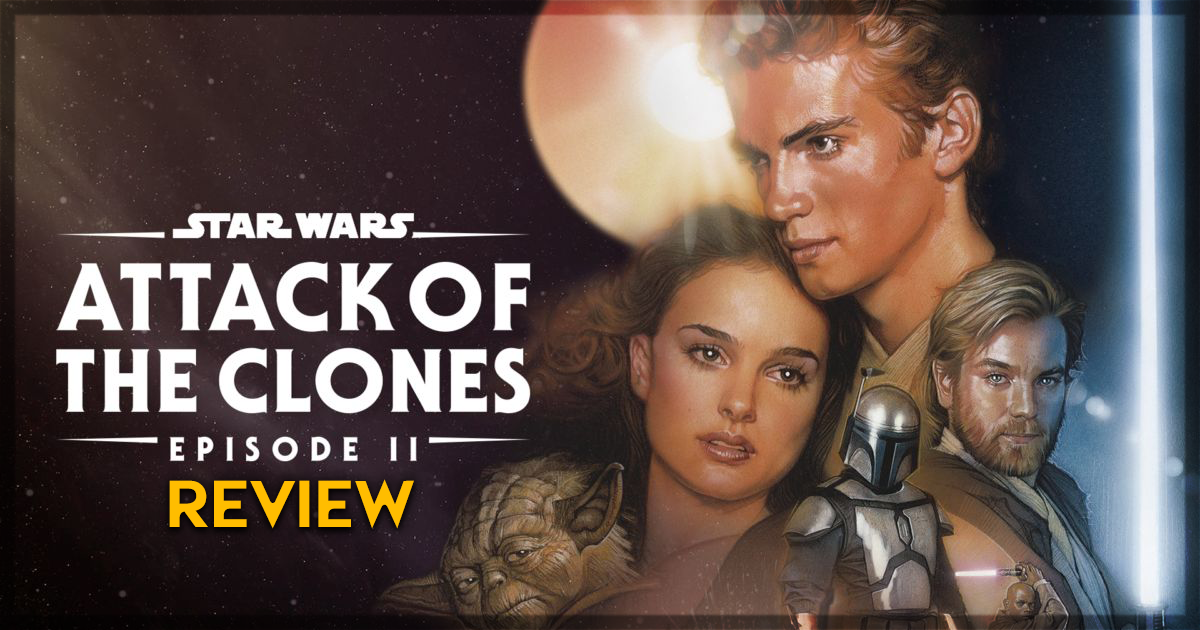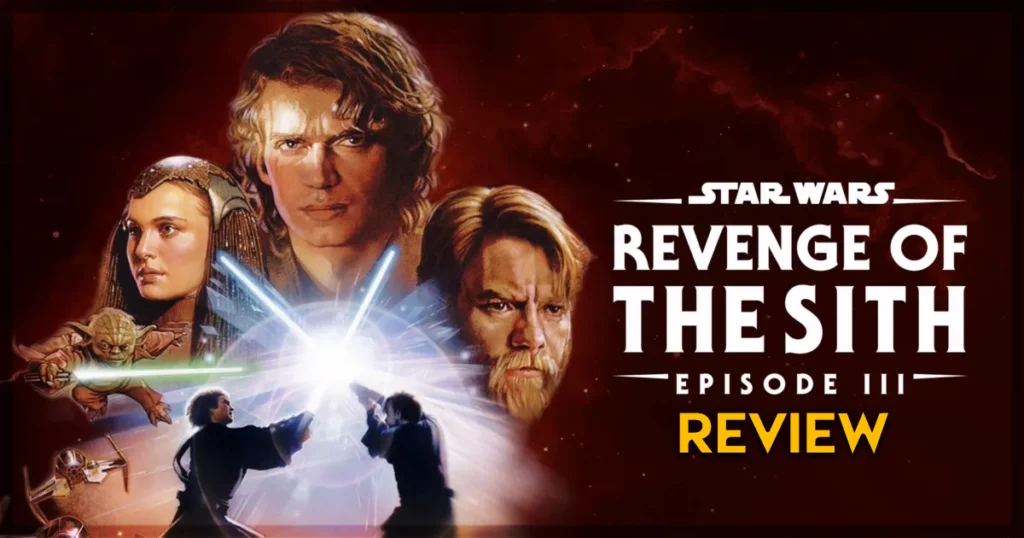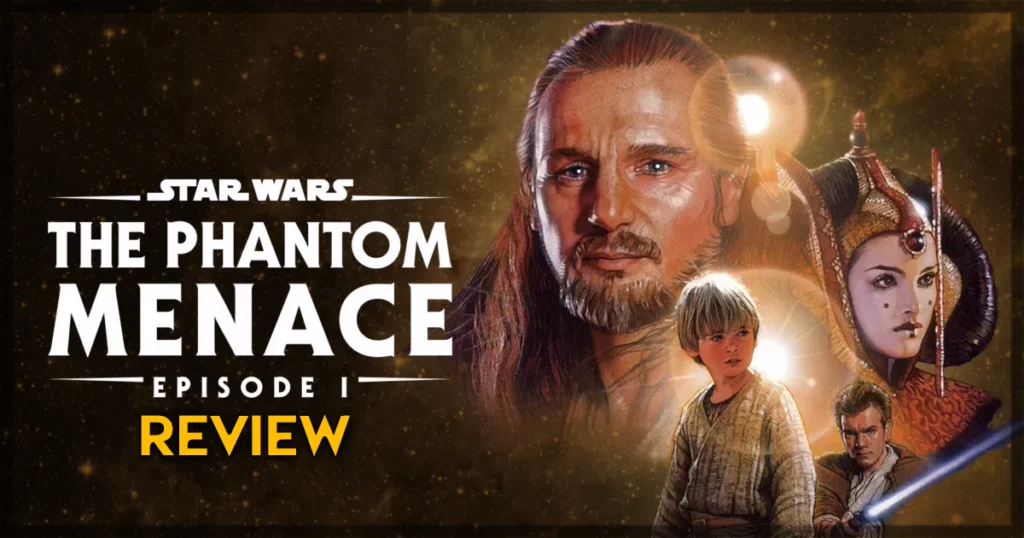If my review for The Phantom Menace could be perceived as me going out of my way to be fair, then Attack of the Clones is me reaping what I’ve sowed. Not only does this film suffer from many of the same issues as its predecessor, but it amplifies them and throws in its own unique flaws. It’s periodically entertaining but is constrained by overwriting and lifeless CGI, fundamentally lacking the hokey thrills that most of the other movies in this saga pride themselves on.
The second of the Star Wars prequel trilogy (1999-2005), the film takes place ten years after The Phantom Menace. The Republic is on the brink of civil war, with several planetary societies having seceded to form the Separatists, led by former Jedi Count Dooku (Christopher Lee). Tensions spike when a failed assassination attempt is carried out on Padme Amidala (Natalie Portman), now a senator for Naboo. Obi-Wan Kenobi (Ewan McGregor) is sent on a mission to track down the people behind this ploy while his gifted but reckless padawan Anakin Skywalker (now played by Hayden Christensen) serves as Padme’s personal security. As Obi-Wan uncovers a grand collusion, Anakin and Padme find themselves falling in love, despite their life roles preventing such a possibility.
Attack of the Clones tells two stories that then converge during the third act, where a climactic battle ensues. One is a political conspiracy about how democracy is gradually being eroded by corruption and disillusionment; one that sees Obi-Wan travelling to various worlds and discovering the titular clone army in question. The other is a forbidden romance between an overly emotional warrior with a hero complex sworn to reject emotions by his misguided order, and a politician who has dedicated her life to the best interests of others, thus leaving her out of depth when it comes to pursuing her own desires. On paper this sounds epic.
However, neither of these storylines take enough advantage of cinema’s inherently visual platform, something which is so disheartening given writer-director George Lucas’s proficiency with visuals. The reason the binary sunset scene from A New Hope is one of cinema’s greatest moments is because it says everything about Luke’s character with just a few choice visuals. Even The Phantom Menace would occasionally let the visuals speak for themselves; such as the pod race sequence where close-ups would determine cause and effect. With Attack of the Clones, practically everything is force fed to us through dialogue. Significant narrative or political developments are spelled out; characters’ emotions are vomited out at any given moment; even the action scenes, be it lightsaber duels or a spaceship chase through an asteroid field, are laden with quips.
Lucas has been on record stating that romance is not his strong suit, but the love story between Anakin and Padme is painfully unconvincing. Never mind the mind-meltingly wooden dialogue they share – which includes “I’m haunted by the kiss that you should have never given me”, “I am truly, deeply in love with you” and the now iconically memed “I don’t like sand” – but the character arcs are rushed and incomplete. Anakin dictates from the start that he’s pined for Padme for years but Padme’s shift from platonic to romantic feelings is so sudden that it’s impossible to pinpoint what caused it.
At times the characters’ ideologies seem so opposite that a romance between them feels antithetical to their beliefs. One could perhaps make the argument that Padme is attracted to Anakin’s unfiltered earnestness – he wears his heart on his sleeve in contrast to the deceptive world of politics Padme occupies. But this storyline is so undercooked that their dynamic feels awkward and forced rather than natural. Where Anakin is at least a character defined by his entitlement and lack of emotional control, Padme’s agency is mostly in service to the romance, a real downgrade from her role in The Phantom Menace. Christensen and Portman have moments of chemistry, but otherwise their performances are stiff and one-note, hampered by the corny, overwritten dialogue they have to recite.
Turning to the film’s political plot isn’t much better as it’s littered with convoluted overstuffing. Once again there are many scenes in which characters sit around and discuss politics rather than the film engaging with the political themes in thrilling visual ways. It’s a lecture rather than an experience, which is a pity as there is something genuinely interesting about the film’s showcasing on how disillusionment can be as harmful to a democracy as active undermining. In attempting to fit in as many cool lore drops and plot points as possible, the themes unique to the picture become stale and the pacing really starts to drag.
When the film attempts to excite visually the abundance of poorly aged CGI sours the experience. The dissonance between live-action and the digital backgrounds is so rough that, at times, it feels like watching a flight simulator. Some of the set pieces are even lacking the imagination that previous Star Wars films, including The Phantom Menace, basked in – such as a scene where Obi-Wan visits a diner on Coruscant; a diner that looks and feels exactly like a 50s American diner, only with robots as the waiters. The catacombs of the planet Geonosis is essentially just another big desert, and the gargantuan battles of the climax are hindered by obvious choreography and slow movements, a consequence of the numerous characters some of these scenes employ to create a sense of scale. There’s a weightlessness to the action and craft that robs the film of any adrenaline rush.
As a continuation of the prequels’ core thesis on how suppressing emotions leads to destruction, Attack of the Clones has its highlights. We get to witness Anakin’s first step to the dark side when one of his emotional attachments is tragically ripped from him, his Jedi training not sufficiently preparing him for how to handle loss or grief. Christensen’s performance is rather weak on the whole, but when he is using facial expressions instead of dialogue, he scarily captures the ticking time bomb Anakin is becoming underneath the entitlement and inability to freely embrace his attachments. When twinned with the political erosion Obi-Wan’s story is exploring, there is plenty of thematic material in theory. It’s just a shame to see most of it shelved in favor of poor effects and a stilted romance.
It’s not a complete flop though. Where comedy was a low point for The Phantom Menace, humor is consistently strong in Attack of the Clones. Some sequences include a mix-up between a battle droid and the robot C-3PO (Anthony Daniels), as well as a small exchange where Obi-Wan uses a Jedi mind trick on a drug dealer. Both are legitimately funny because they play around with the idiosyncrasies of the characters and their circumstances. Even Anakin and Padme’s dialogue gets noticeably better when they are given the luxury of joking around. The acting is a mixed bag but standouts include McGregor and Christopher Lee, who gives the antagonistic Count Dooku an intimidating amount of gravitas. John Williams’ score is, of course, terrific. Ironically, the musical track that encompasses Anakin and Padme’s romance – Across the Stars – is one of the best tracks from any Star Wars film. Tragic, apprehensive, and beautiful simultaneously, it celebrates love as an emotional attachment to be savored and protected rather than ignored as the Jedi would have it. This amazing track does more for the romance it’s serving than the script, which is sadly the root cause of nearly all of the film’s problems.
I will refrain from labelling Attack of the Clones the weakest Star Wars film for now, as I am yet to revisit The Rise of Skywalker as of when I’m writing this. But it really is a fumbled bag of a picture. Despite promising romantic and action-packed spectacles, its script is the definition of clunky. The convoluted nature of its themes and narrative is outclassed only by the mechanical dialogue and cumbersome love story. Bursts of fun keep it from being godawful, but its reluctance to indulge in Lucas’s visual strengths in favor of flimsy writing really sinks its ambitions. Awkward rather than adrenaline-charged and bloated rather than breezy, Attack of the Clones is less of a march towards a thrilling Star Wars epic and more of a sluggish limp.
2 stars
Star Wars: Attack of the Clones (Episode II) is available to watch on Disney+.
Learn more, including how to watch, at the Disney+ site for the title.



